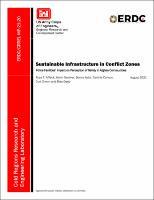Please use this identifier to cite or link to this item:
https://hdl.handle.net/11681/41700| Title: | Sustainable infrastructure in conflict zones : police facilities’ impact on perception of safety in Afghan communities |
| Authors: | Affleck, Rosa T. Gardner, Kevin H. Deeb, Elias J. Aytur, Semra Carlson, Cynthia Grimm, Curt |
| Keywords: | Afghanistan Infrastructure development Perceived safety Police confidence Resilience Stability Sustainability Trust War-torn environment |
| Publisher: | Cold Regions Research and Engineering Laboratory (U.S.) Engineer Research and Development Center (U.S.) |
| Series/Report no.: | Miscellaneous Paper (Engineer Research and Development Center (U.S.)) ; no. ERDC/CRREL MP-21-20 |
| Is Version Of: | Affleck, Rosa T., Kevin Gardner, Semra Aytur, Cynthia Carlson, Curt Grimm, and Elias Deeb. "Sustainable infrastructure in conflict zones: Police facilities’ impact on perception of safety in afghan communities." Sustainability 11, no. 7 (2019): 2113. https://doi.org/10.3390/su11072113 |
| Abstract: | The notion of sustainable infrastructure for the delivery of social services is to fulfill basic human needs; in war-torn societies, human safety is a critical basic need. The relationship between sustainable infrastructure development and human safety remains under-researched in Afghan neighborhoods. Therefore, this study examined the effectiveness of the police facilities constructed for stability enhancement in Afghan communities. To do so, this study used Afghans’ polling datasets on the police presence and the public safety perceptions, including newly collected survey data related to the influence of the police facilities on human safety and other factors contributing to the neighborhoods’ well-being. The datasets are organized with a multilevel structure in which different individuals are sampled within neighborhoods and analyzed using a multilevel model approach to capture the randomness of the responses. The results showed that police facilities are more important to perceptions of safety in less safe areas and that Afghans in villages perceived themselves as safer than in urban areas, relative to their own immediate region. Those perceiving themselves as being safer were older, more highly educated, and widowed respondents. Overall, Afghans perceived the police facilities as institutional symbol for promoting improvements and opportunities for fulfilling basic human safety need. |
| Description: | Miscellaneous Paper |
| Gov't Doc #: | ERDC/CRREL MP-21-20 |
| Rights: | Approved for Public Release; Distribution is Unlimited |
| URI: | https://hdl.handle.net/11681/41700 http://dx.doi.org/10.21079/11681/41700 |
| Appears in Collections: | Miscellaneous Paper |
Files in This Item:
| File | Description | Size | Format | |
|---|---|---|---|---|
| ERDC-CRREL MP-21-20.pdf | 643.64 kB | Adobe PDF |  View/Open |